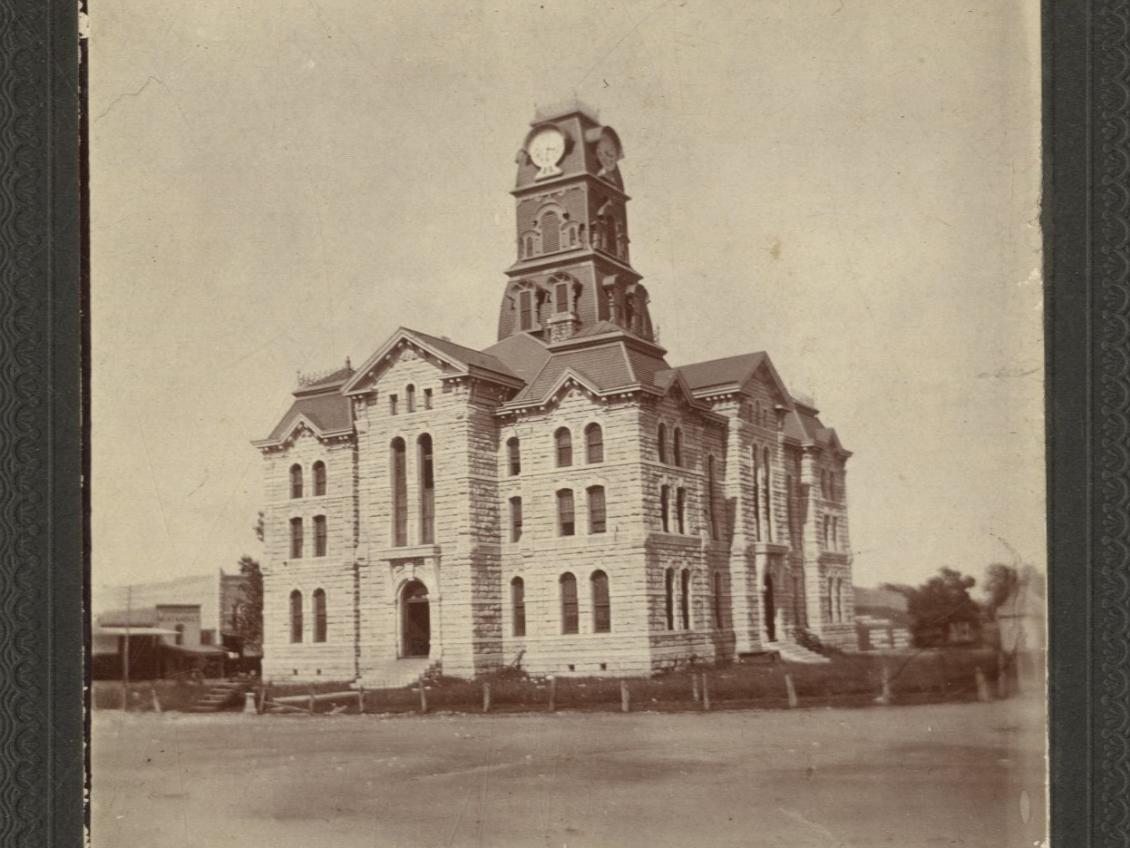
Welcome to Visit Granbury’s history blog! Granbury, Texas is a vibrant, modern Texas city, but its historic roots run deep. We in Granbury are proud of our Texas heritage. Many of our county’s citizens still make their living from agriculture including productive cattle and horse operations. Our city motto is, “Where Texas History Lives,” and we hold bragging rights to the title of “Best Historic Small Town in America – three years in a row in the USA Today Reader’s Choice Survey. Our downtown square, housing the beautiful Hood County Courthouse built in 1890-1891 in the French Second Empire style, is surrounded by turn-of-the-century limestone and brick buildings, all retaining their Victorian Style and charm. But there is so much more to Granbury than its fascinating shops, great restaurants, engaging art galleries, restful hotels and B&B’s, fun entertainment venues, water sports opportunities, wineries, and thousands of acres of beautiful ranchland outside of town. There is a wealth of information at every turn around the courthouse square on the many Texas historical markers mounted along the sidewalks telling the stories of historic Granbury. We also offer no less than six history museums, each with a different flavor, within comfortable walking distance from the downtown square.
This history blog will provide ongoing content to inform and entertain you about the amazing people and events that created and developed the “Best Historic Small Town in America.” Check back frequently for more Granbury history bits and pieces. We hope you enjoy your visit to Historic Granbury, Texas, and come back soon, Y'all!
Granbury Texas History in Bits and Pieces
Was Granbury really part of the “Wild West?”
You couldn’t get much wilder than the raw country on the west side of the upper Brazos River in the mid 1850’s. Warlike Native American tribes including the Comanche and Kiowa resisted settlement. Comanche Peak, a significant natural landmark along the Brazos River a few miles southwest of present day Granbury, was a meeting place for different tribes. Indian attacks, cattle rustling and horse thievery was not uncommon, but was met with swift frontier justice by the farmers, ranchers and townspeople. The frontier of Texas drew a tough breed of people in the years surrounding the Civil War. Men had to be tough to have survived the war and deal with the day-to-day challenges. The women had to be just as tough to simply exist in the face of everyday hardship that frontier and early Texas life dealt them.
Why did people want to move to this part of the country?
It was very attractive because the land was free in some cases or very inexpensive to buy. Farmers and ranchers could own much more land here than they could ever own back in the United States. It had abundant natural resources including good soil for farming or ranching and plenty of wildlife for hunting and the climate was comfortable most of the year.
When did people start moving across the Brazos River?
A few brave families started moving to the west side of the Brazos into what had been considered Indian territory and building their homes in the mid 1850’s.
Who were the first settlers that moved into this undeveloped part of Texas that would become Hood County and Granbury?
Several adventurous men from Missouri explored the vast area of north central Texas along the Brazos river in the mid 1850’s looking for opportunities to re-settle their families. They found what they were looking for along a bend in the Brazos River about three miles north of present day Granbury. They named it Stockton Bend. Those men were representatives of the Bond, Nutt and Landers families. Amon Bond, David Nutt and Abel Landers and their offspring became community leaders and the driving forces behind the development of Hood County and the town of Granbury. Other early settlers and contributors to the development of the community were Tommy Lambert and Austin Yeats. Several brave families settled in the Squaw Creek and Paluxy areas in the mid-fifties as well. Elizabeth Crockett, the widow of Texas Independence War hero David Crockett, her two sons and a daughter and their families also moved from Tennessee and settled in the Rucker Creek area on her husband’s Republic of Texas veteran’s land grant at about the same time as the Stockton Bend settlement.
Why did the Bond, Landers and Nutt families leave Missouri?
There was a tremendous amount of turmoil in Kansas and Missouri during the years leading up to the civil war. The argument had to do with conflicts between the pro-slave and anti-slave factions in those areas. Some would say that that the violent raids and on-going attacks back and forth between those groups led to the civil war itself. The Bond, Landers, and Nutt families were against slavery and the violence that went with the challenge between the two factions. They could see their country was rolling down a path toward destruction with no resolution without a terrible civil war. They believed the only way to save their families, especially their sons, from becoming embroiled in the conflict was to remove them to a more peaceful climate. The vast openness of the unsettled areas of Texas appeared to provide that opportunity.
Were these new Texans able to avoid the conflict of the Civil War as they hoped?
No, even the remoteness of the western frontier of Texas couldn’t provide enough distance between the new Texans and the fires of unrest, disagreement and division back east. It followed them. The Texas government ultimately seceded from the union and aligned with the Confederacy in the spring of 1861. Union sympathy during the war was not tolerated through the south, including Texas. But the wisdom of the community leaders in the little village of Stockton Bend kept those sparks of dissention under wraps. Some other Texas communities weren’t so fortunate. Over 40 union supporters were hanged in Gainesville, Texas in 1862 because of their beliefs. Some German communities in the Texas hill country evacuated to Mexico rather than support Confederate values. The Conscription Law of 1862 drew sons of the Stockton Bend community into the war along with thousands of other Texans. Many never returned home.
What were conditions like at home on the Texas frontier during the Civil war?
Farmers and ranchers that had settled in remote parts, west of Stockton Bend were frequent targets of surging Indian raids; stealing horses and other livestock. Hardly a full moon passed without Comanches and Kiowas plying their trade of thievery and associated attacks on isolated farming families scattered around the area. With so many men away involved in the war, the frontier protection militia was sparce and many farms and ranches were left unprotected. Indian attacks caused the frontier to actually shrink back toward the settlements because so many of the raids were unchecked.



